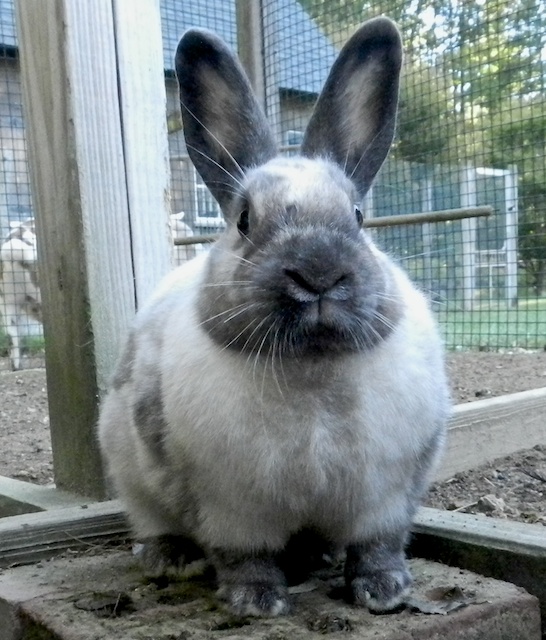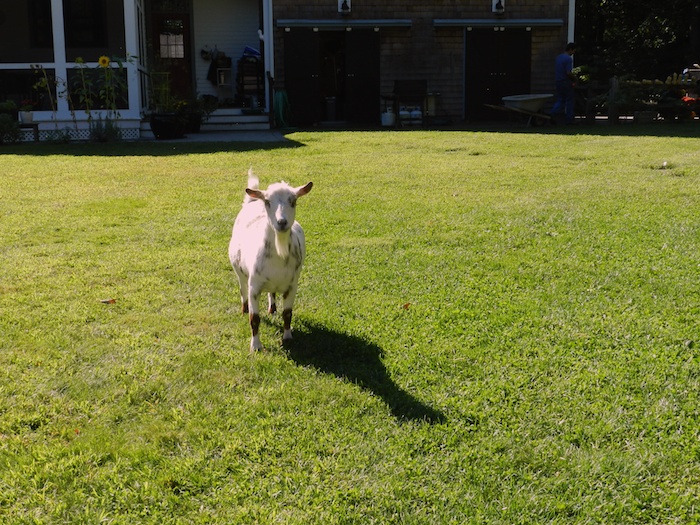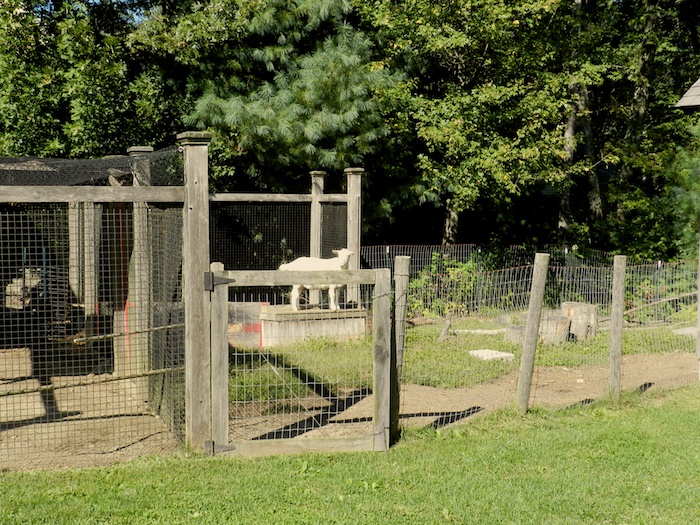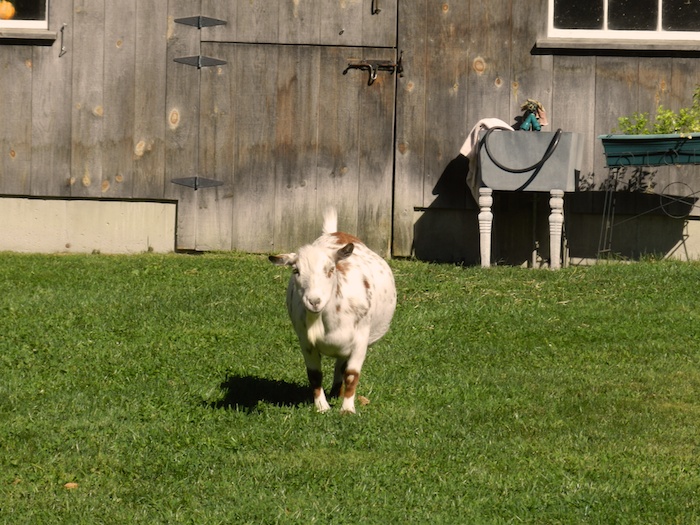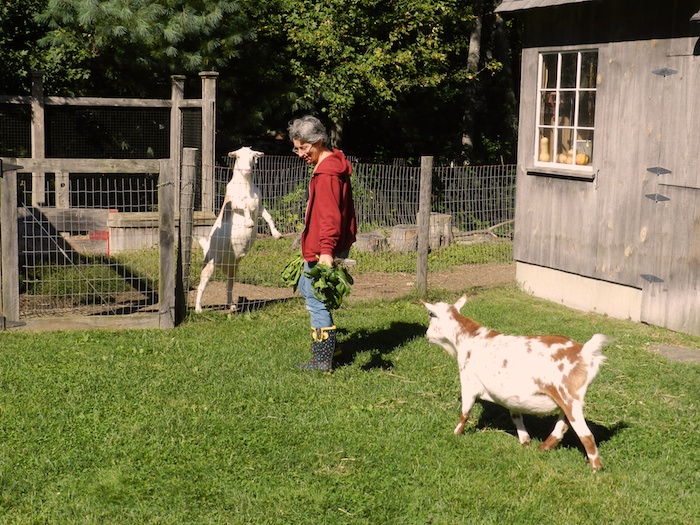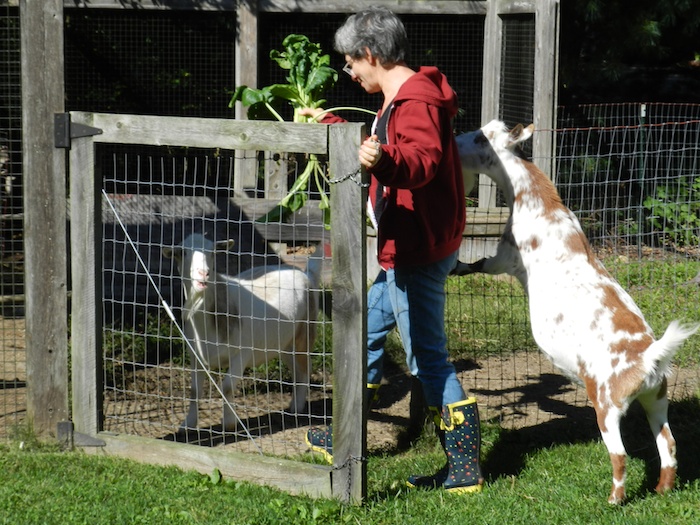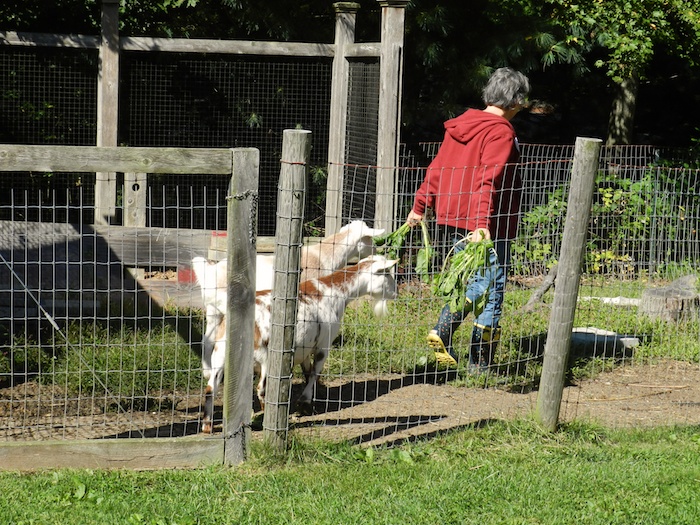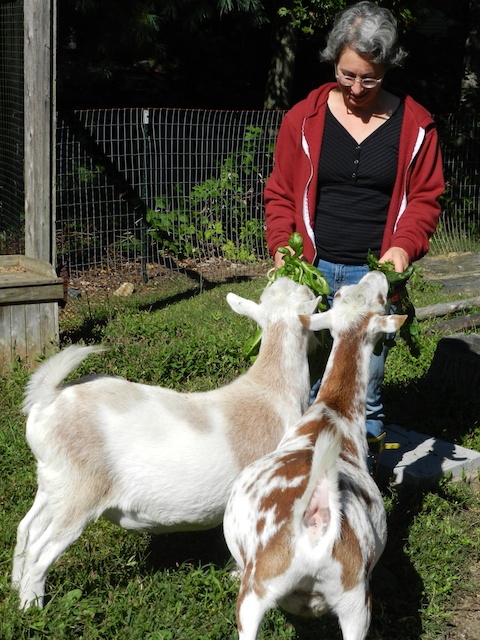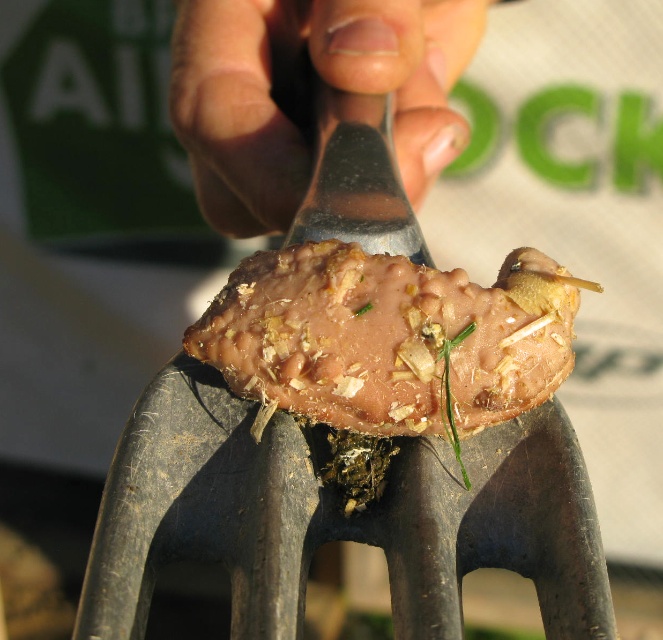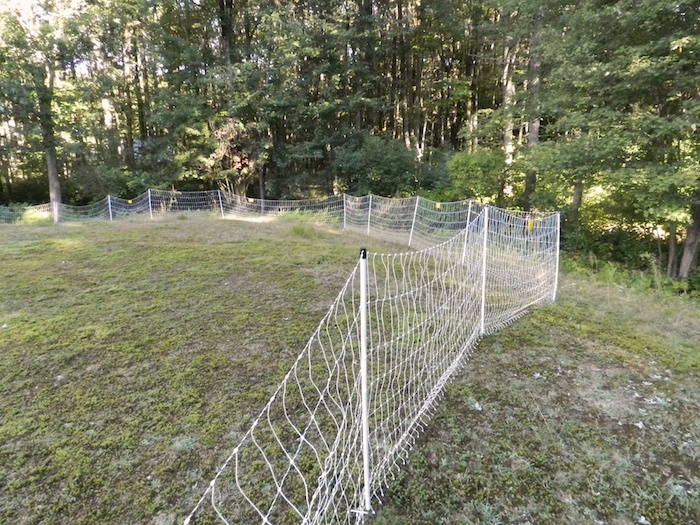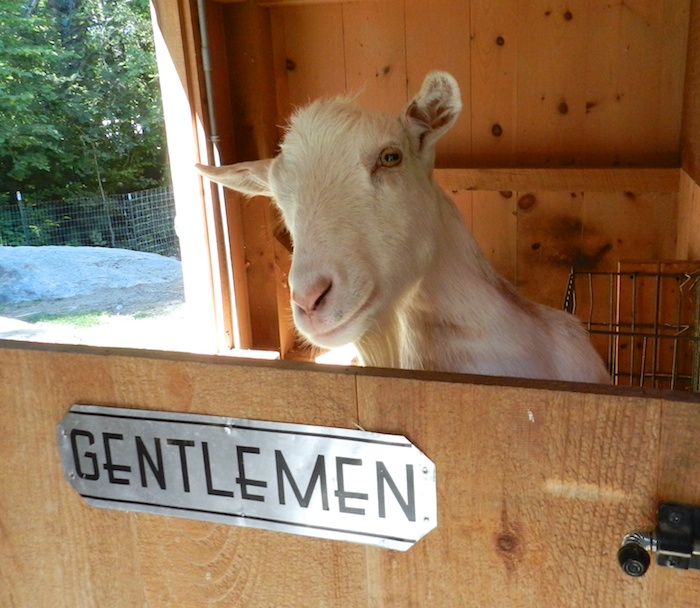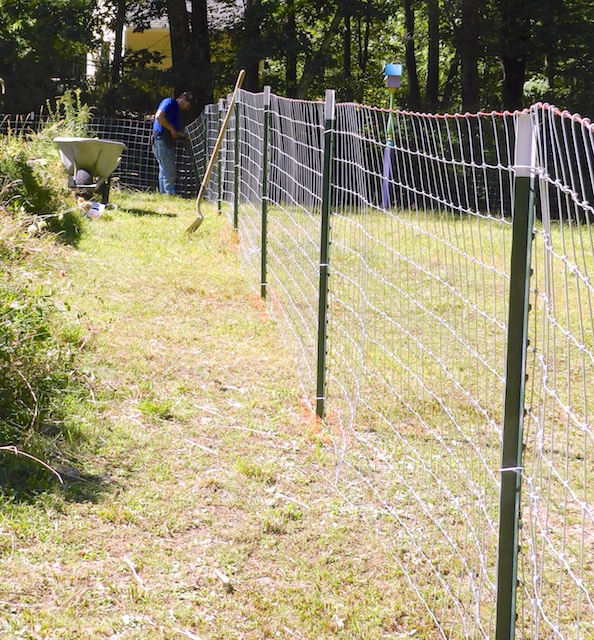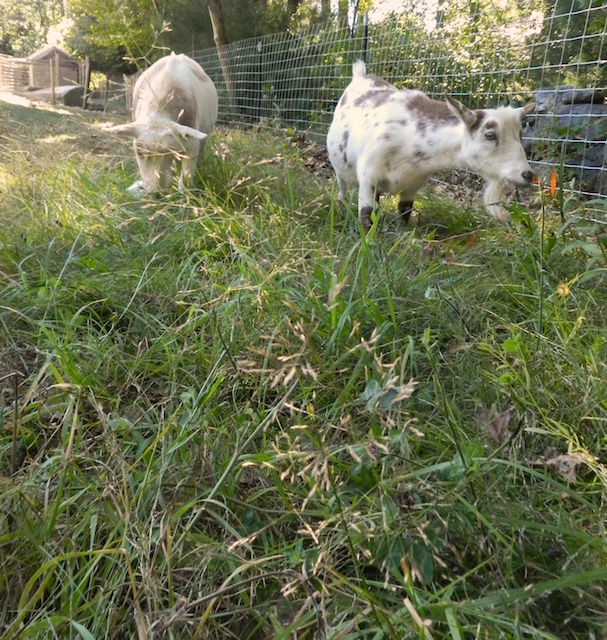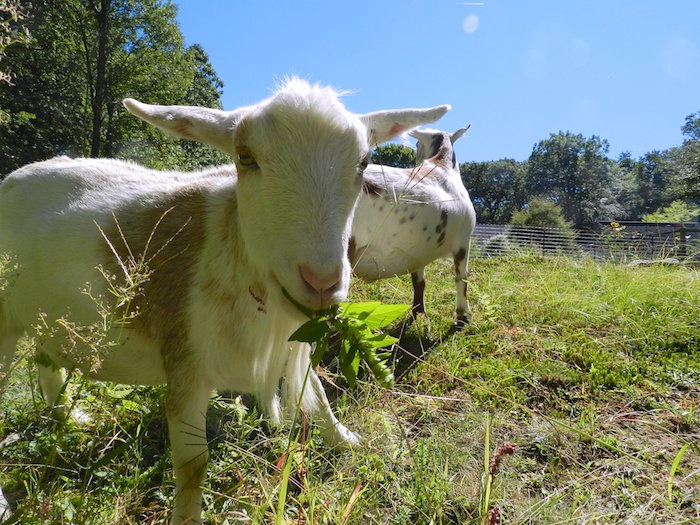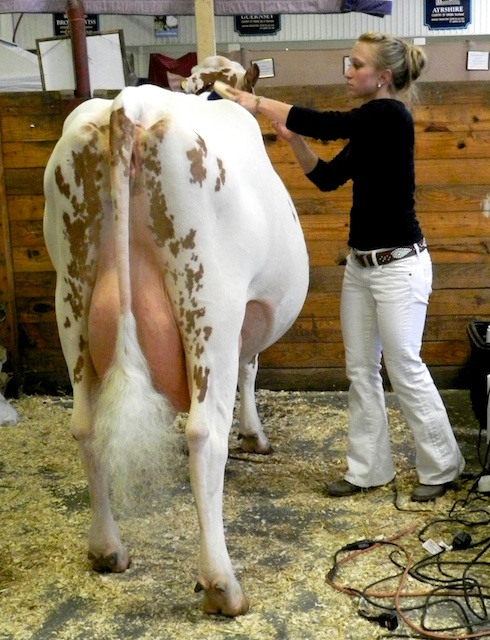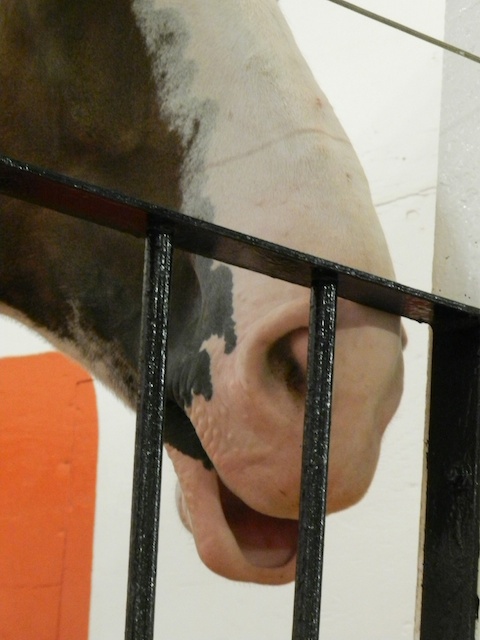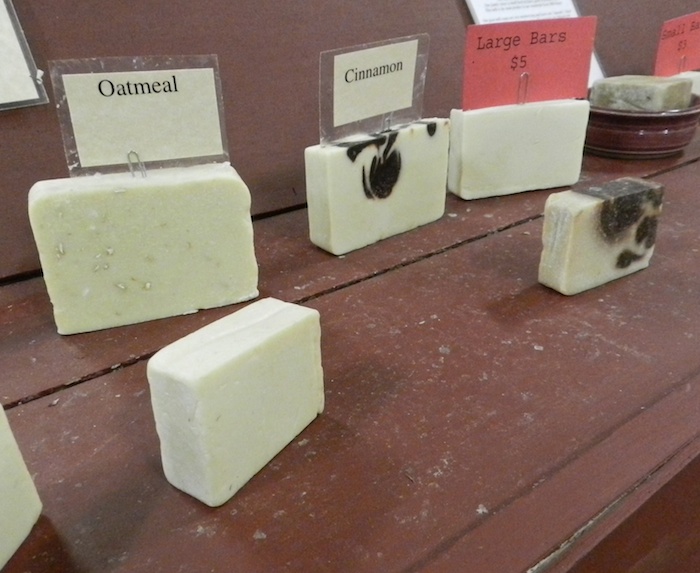Phoebe is ready for winter. She’s put on a layer of fat. She’s grown a thick coat. Bring it on.
Escape Goat
The other day the Goat Maid found one goat in the backyard. Caper was happily eating crabgrass.
His brother, Pip, was still in the paddock, standing in the sun on his bench. The gate was closed.
Was Caper some sort of magician? No, the bottom chain had been inadvertently left unlatched. Pip said that it looked closed to him, and that the opening was far too small to squeeze through.
Caper, however, saw it differently. Caper said that the gate was wide open. Really. He said that the Goat Maid wanted him to graze on all of this lovely green grass. He’s a well-behaved boy. He wouldn’t go far. He wasn’t even eating the parsley!
The Goat Maid’s geometry skills are not up to calculating how that belly could fit through the gap in the fence. But, she did know how to get him back. Chard. Notice that Pip is eager to eat the greens, but that he does not go through the gate.
Caper, clever boy, tried to figure out how to eat the chard while staying on the grassy side. However, he was not as clever as the Goat Maid (at least not at this moment.)
The gate was closed (and about to be latched, top AND bottom.)
The goats ate chard. Good boys!
Lash
I recently heard from a reader who had a very sick chicken named Norma. The hen was listless, left greenish poo, and her comb turned darkly purple. After a dose of epsom salts per my spa treatment (this hen was given this orally) Norma revived a bit, walked about and began to eat again.
She then expelled something that looked quite alarming to her owner. This:
This is a lash. I don’t know when I first heard the term lash. I believe it was on a British poultry forum. I have tried to trace it back to its origins, but can’t find any solid information. There is nothing about lash in any of my poultry keeping books, not in Gail Damerow’s tomes, nor in my vintage guides. What I know about this comes from my hands-on investigations. I do necropsies and have seen such masses inside of chickens. It is not, as is often erroneously claimed on internet forums, a piece of the reproductive tract. It is not a tumor. It is composed of eggs that have become compacted and possibly infected. I’ve seen them small as jelly beans and as large as my fist. Sometimes, when you cut into a lash, there is the yellow of yolk. Sometimes it is built of all whites. Sometimes there is a membrane from a shell. Depending on where the lash is in the hen’s body determines how severely it affects the chicken. If it stays in the reproductive tract and isn’t too large, it might block things for awhile, but then with the laxative effect of epsom salts, it will pass, and the hen, much relieved, will revive, as did Norma.
But, sometimes, there is a rupture in the reproductive tract and the mass passes into the body cavity. (I have been able to find information about ruptures in my resources.) Many eggs can accumulate there, each solidifying from infection, and pressing on the hen’s organs. I’ve seen hens look ill, recover, and look ill again, as these masses shift and block functions, and then move again out of the way. Siouxsie lived with one, likely for two years, before she died of it.
Sometimes the hen doesn’t have a ruptured tract, but her eggs are pushed up the oviduct and out the infandibulum near the ovaries (instead of down and out the vent and into the nesting box.) These eggs are usually shell-less can cause a build-up of fluid in the abdomen (once infected they contribute to cases of peritonitis.) This is often the cause of internal laying. Sometimes, they harden and become like the mass you see in the above photograph.
There is no knowing whether your your listless hen is suffering from lash by looking at her. Many other diseases cause a hen to droop or stand like a miserable penguin. There is also no way of knowing if it is one small lash, like Norma expelled, or whether her body is filled with them. But, the course of action is the same. Do the spa treatment. If the blockage can be passed out, then this will help. If you don’t see a change within 48 hours, then there’s not much to be done. You could try a general antibiotic like Duramycin. That might prevent internal laying from turning into peritonitis, and it can possibly stop the lash from getting infected. But you never know. Perhaps there is no lash, perhaps it’s something else. I have been surprised by what I’ve found doing necropsies. The range of ways that a hen shows illness is small compared to the many things going on inside of her.
Expelling a lash can be a one-time occurrence and the hen might go on to live for another year of laying. Or, it could be an indication that something is very wrong with her and it could be the beginning of her decline and demise. Give her a soak in epsom salts, and let her live her life with her flock. That’s what Norma’s owner did, and her comb is back to red and she’s back to her old self. Norma might decline again, but, that’s how it is with backyard laying hens. You give them a good life and do the best you can.
note: If this post has been useful to you, please consider sharing it with your own poultry community. I’d like this information and my writing to reach a larger audience. Thank you.
A Goat Fence
An author never knows how much she is going to earn on a book. Usually it’s not much. The publisher pays me an advance against future sales. Out of that, I pay the photographer, the indexer, and my grocery bills from all of the recipe testing. It’s rare that an author “earns out the advance” and makes anything beyond the first payout. Still, it is a fine thing to deposit that check. I recently did so (an advance for the upcoming Farmstead Egg Guide and Cookbook.) I decided that I had just enough for one splurge.
Some women would buy this.
I bought a goat fence.
The goats have a small permanent paddock that you see on the GoatCam. Behind the barn is a grassy mound that I like to call a meadow. For the last four years, I’ve used an electric fence.
The good thing about the electric fence is that I can move it about, so that as the goats graze down one area (as seen here) I can move it to the proverbial greener pastures. However, there are times when the ground is too hard to push in the stakes and it doesn’t get moved. Also, I’d like to let the goats into edges of the woods, but it’s too rocky to install the fence there. In the winter, with ice and snow, the fence gets taken down and the goats are limited to their paddock. So, with my advance in hand, I called a fence company.
It took two men two days to put up the permanent steel wire fence, during which time, the goats were closed up in their paddock.
The goats were disappointed not to be able to assist the guys. But the men brought a boom box and listened to loud rock music. The goats enjoyed that immensely.
The goats wagged their tail with glee when their gate was opened to their reconfigured pasture. There were all sorts of plants to eat that they had only been able to eye in the past.
If you’ve noticed in the last week that their bellies are particularly rotund, now you know why.
At The Big E
There’s no better way to spend a fall day in New England than to go to an agricultural fair. Steve and I spent our 21st wedding anniversary at the biggest fair in this region, appropriately named the The Big E (E is for Exposition.) This extravaganza is crowded with things I’m not interested in: the midway, the booths selling sham-wow towels, and the B-list entertainers. But, under the commercialism and the glitz, at its heart, the Big E remains true to its farming roots. In fact, we were there as guests, because Steve entered a photography contest for the Massachusetts Agriculture Calendar. His shot of a neighbor’s beef cattle is the October page! (Stay tuned to this website. They still have last year’s calendar up, but 2014 will be for sale soon.) We attended a ceremony at the Massachusetts State Building, listened to a few bureaucrats (ones that actually do good work!) and a politician, were handed a gift bag and a calendar, and then we had the day to roam the grounds.
Although thousands of people go to the Big E for the fried snacks and ferris wheel, scores end up entranced at the chick hatchery. For many people, this is their only chance to see live chickens. 2880 eggs are hatched during the two weeks of the fair, so there is always a chick or two to watch tumbling out of an egg. Kudos to the FFA for sponsoring this small corner of magic at the fair.
We stopped at a demonstration of sheepdog work – it’s easier to show this in a small space using ducks! I could spend all day watching Indian Runner ducks running back and forth like fussy waiters in tuxedos.
Animals were getting cleaned up for showing. This cow wasn’t going to stay white for long. The handler had a good sense of humor about it.
This ram was not yet groomed. He was nonchalant about all of the hubbub around him.
Commadore, a Clydesdale who is part of the 8-horse Hallamore team, was also quite relaxed.
He was a gentleman while getting harnessed in front of the public.
Just look at the size of those hooves!
It takes a long time to hitch up eight horses that are six feet tall at the withers and weigh 2200 pounds each. We watched for a long time, but then moved on, because there were pigs to see (also, you’ll note, relaxed.)
There were displays of crochet, photography and decorated pumpkins. I was quite taken with this gourd, painted like birch bark and carved into a birdhouse.
I skipped the booths peddling jewelry made in China, but I did go shopping. I came home with a pair of cowboy boots, and goat milk soap, bought directly from the farmer.
Of course, everywhere we went there there were opportunities to eat fried food. Honestly, it didn’t look very good. What was delicious was the big, perfectly baked potato filled with New England butter and sour cream that I bought in the Maine State Building. That was delicious.
I hope that you get out to a fair soon. Tell me about it!
